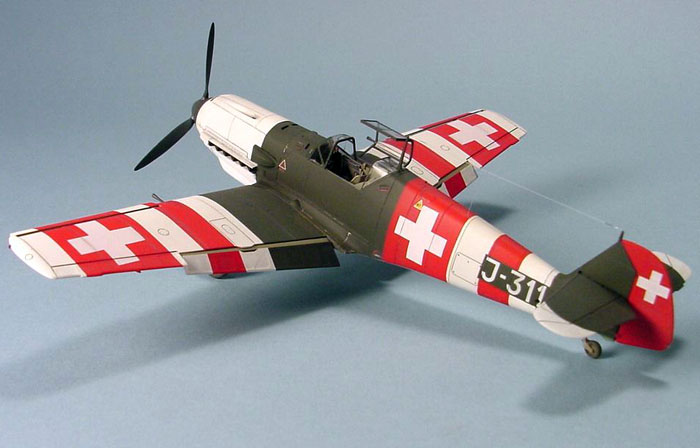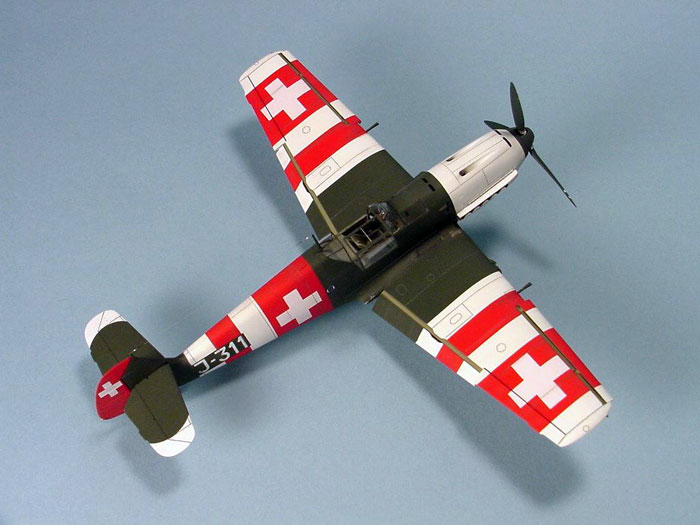|
Tamiya's 1/48 scale
Messerschmitt Bf 109E-3
by Randy Lutz
|
 |
|
Swiss Messerschmitt Bf
109E-3 |

Tamiya's
1/48 scale Bf 109E-3 is available online from
Squadron.com
Here are some images of my Swiss Messerschmitt Bf 109E-3.
Some of you viewers may be aware that my modelling choices are primarily
dictated by schemes rather than subject matter and this model is a
textbook example. I do not particularly care for 109s, but I do like
Swiss markings and in this case, the markings won.
One needs good reference and the best books on Swiss Me-109s are the
Squadron Walk Around No. 34 Messerschmitt Bf-109E by Hans-Heiri Stapfer
and Die Messerschmitt Me 109 in der Schweizer Flugwaffe - ein Stuck
Zeitgeschichte, by Georg Hoch. Prior to actually looking at any
reference material, I thought that building a Swiss Emil was a simple as
painting some red and white stripes. Man was I way off base. All totaled,
there is 11 separate modifications that are required to accurately model
a Swiss 109E and are in addition to any unique paint and markings that
would be necessary.

Before you can even contemplate making a Swiss 109E-3, you need a kit
and here the possibilities are numerous. You can choose from Hobby
Craft, Hasegawa, Tamiya, or maybe even some other brand, of which I am
not aware. For this build I used the Tamiya kit for no other reason than
the fact that it was the only E-3 I had in the pile.
The 11 different mods that were required are as follows:
-
Modify the engine cowling, by
removing saddle bag gun breech bulges and the raised flange around
the gun troughs and new panel lines have to be scribed in place.
-
Swiss Me-109E-3's were fitted with a
KG 11 spade grip.
-
The Swiss Emil's had a rather unique
looking throttle grip in lieu of the standard cylindrical shaped
German grip.
-
Swiss Emil's were fitted a Morse Code
telegraph key on the bottom right side of the instrument panel and
the Swiss were trained to use this for communication instead of
voice communication.
-
A final cockpit modification which is
unique to Swiss Emil's is the cannon arming key hanging from a
leather strap. This particular feature was installed late in the
Emil's service with the Swiss Fliegertruppe, so it would not be
correct for an early war 109E-3.
-
Swiss Emil's had side-by-side 7.45mm
Eidgenössische Waffenfabrik (EW) MG 29 machine guns in the cowl.
-
The addition of two
rectangular/oblong bulges on top of the fuselage, immediately behind
the gun compartment gas vents.
-
Depending on the time frame of your
model of a Swiss 109E-3, it could have an additional vent located
behind the cockpit.
-
Swiss Emil's had an extra access
hatch on the lower rear fuselage, situated one panel behind the
first aid access.
-
It is necessary to replace the German
20mm Rheinmetall-Borsig MG FF wng cannon with a conical shaped blast
tube, with 20mm Oerlikon FF K Oe 37 cannons which feature a funnel
shaped blast tube.
-
In the Swiss 109's, the antenna wire
lead-in is situated one panel further forward than that of its
Luftwaffe counterpart.
As good as the Tamiya kit is, it is not
without faults. One of the major problems with the kit relates to the
mounting position of the stabilizer braces. If installed without any
corrective action, the stabilizers will exhibit anhedral due to the fact
that either the braces are too short or positioned incorrectly. Don't
know for sure what the problem is and I don't care, but I know how to
fix it easily.
With the airframe assembled, it is at the stage where you can tackle the
one feature that really distinguishes a Swiss 109 from all others,
namely the paint job, as everything done to this point will be lost on
all but the most ardent Messerschmitt aficionados. Swiss 109's went
through a variety of paint and marking schemes depending on the time
period. I have always liked the flamboyant red and white patterns, so I
elected to finish my model in the neutrality scheme from September 1944.

Hopefully this will prove useful to anyone who wishes to build one of
these neutral warriors. One thing I noticed in all the photos I looked
as was the exhaust staining on the Swiss aircraft is not nearly as heavy
as the Luftwaffe machines. I don't know if it is because of different
fuels being used by the Swiss, or maybe they did not run their aircraft
as hard as the Germans, but it is something to keep in mind if you build
one.
I do not have much in the way of the operational history of J-311. What
I do know is J-311 served with Flieger Kompagnie 21 in Olten. But this
was in April 1940 and long before the neutrality stripes were applied.
The photos of J-311 with neutrality stripes that do exist, do not
specify the Flieger Kompagnie or location. Hopefully, some viewer may be
able to fill in the details.
A complete build article with more in depth text is scheduled to appear
in the April issue of Model Airplane Montly magazine.
Click on the thumbnails
below to view larger images:
German Night Fighter Aces
of World War 2
Aircraft of the Aces 20 |
|
|
|
|
Author: Jerry Scutts
Illustrator: John Weal
US Price: $19.95
UK Price: £12.99
Publisher:
Osprey Publishing
Publish Date:
June 5, 1998
Details: 96 pages; ISBN: 1855327147 |
|
|
Model, Images and Text Copyright ©
2006 by Randy Lutz
Page Created 14 March, 2006
Last Updated 14 March, 2006
Back to HyperScale
Main Page
|
Home
| What's New |
Features |
Gallery |
Reviews |
Reference |
Forum |
Search